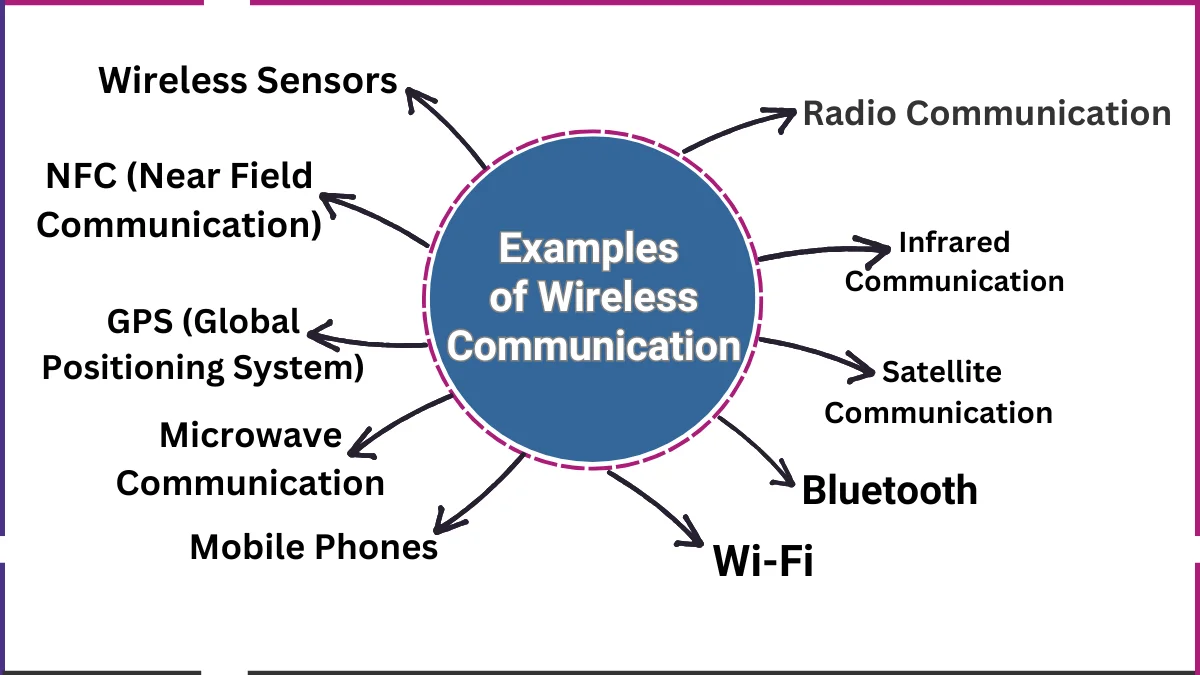Wireless communication means sharing information without using wires or cables. It sends data through signals like radio waves, infrared, microwaves, or satellite signals. This technology helps people talk or send messages even when they are far away. Wireless communication is quick, simple, and easy to use.

Examples of Wireless Communication in real life
These are common examples of wireless communication:
1. Mobile Phones
This is the most common example of wireless communication. We use mobile phones to make calls and send messages. When you call someone, your phone sends signals to a nearby tower. That tower sends your voice or message to the other person’s phone. This all happens in just a few seconds.
Mobile phones work without any wires. You can get signals almost everywhere at home, on the road, in cities, and in villages. Smartphones also have apps, GPS, and cameras. All these things work with wireless technology.
2. Wi-Fi
This is another example of wireless communication. Wi-Fi lets you use the internet without any cables. A Wi-Fi router sends signals that your phone or laptop receives.
Wi-Fi is used in schools, homes, offices, and airports. It is fast and can connect many devices at the same time. Students use Wi-Fi to attend online classes, download notes, and watch videos.
3. Bluetooth
Bluetooth is also an example of wireless communication. It connects two devices over a short distance. For example, you can connect wireless headphones, speakers, or a smartwatch.
Bluetooth works without the internet. It is secure and uses very little battery. Students use it to share files or connect wireless earphones while studying.
4. Satellite Communication
This is a powerful example of wireless communication. Satellites orbit the Earth and send signals to ground stations. These signals help in mobile calls, live TV, the internet, and GPS.
Satellite communication works even in remote areas where mobile networks don’t reach. Rescue teams, the army, and scientists use it in deserts, oceans, or mountains. It is also used in weather forecasting and space research.
5. Infrared Communication
This is another example of wireless communication. It sends data using infrared light signals. Remote controls for TVs, ACs, and other devices use this technology.
Infrared works only when both devices are close and facing each other. The range is short, but it is fast. Many home appliances use infrared, and students see it daily in remote controls.
6. Radio Communication
Radio communication uses radio waves. FM/AM radios receive audio signals from radio stations. Two-way radios are used by police, security guards, and emergency teams.
These radios work in places where mobile signals are not available. They are useful during events, in disaster areas, and in rallies. They provide clear voice messages without needing the internet.
7. Microwave Communication
This example of wireless communication uses high-frequency microwave signals to send data. It requires line-of-sight between towers.
Telecom companies use this to send phone and internet signals over long distances. It is fast and reliable. In remote or hilly areas where cables can’t be laid, microwave towers are used.
8. GPS (Global Positioning System)
This is an example of wireless communication that tells your exact location using satellite signals. It is used in cars, phones, delivery apps, and smartwatches.
When you open a map, GPS tells you where you are and how to get to your destination. Drivers and delivery people use GPS every day.
9. NFC (Near Field Communication)
This is wireless communication between two devices that are very close, just a few centimetres apart.
It is used mostly for contactless payments. You can simply tap your phone or card on a machine to pay. It is fast, secure, and touch-free. Smart tickets and access cards also use NFC.
10. Wireless Sensors
These sensors collect and send data without wires. They are used in weather stations, smart homes, farms, and hospitals.
In smart homes, sensors turn on lights when someone enters a room. On farms, they check the soil and help farmers make better decisions. Sensors save time and improve safety.

